HI5020: Corporate Accounting Report: Westpac & ANZ Analysis
VerifiedAdded on 2023/06/03
|17
|4387
|74
Report
AI Summary
This report provides a comprehensive analysis of corporate accounting, focusing on financial statements and the application of accounting principles in business contexts. The report examines key components of financial statements including owner's equity, cash flow statements, and other compr...
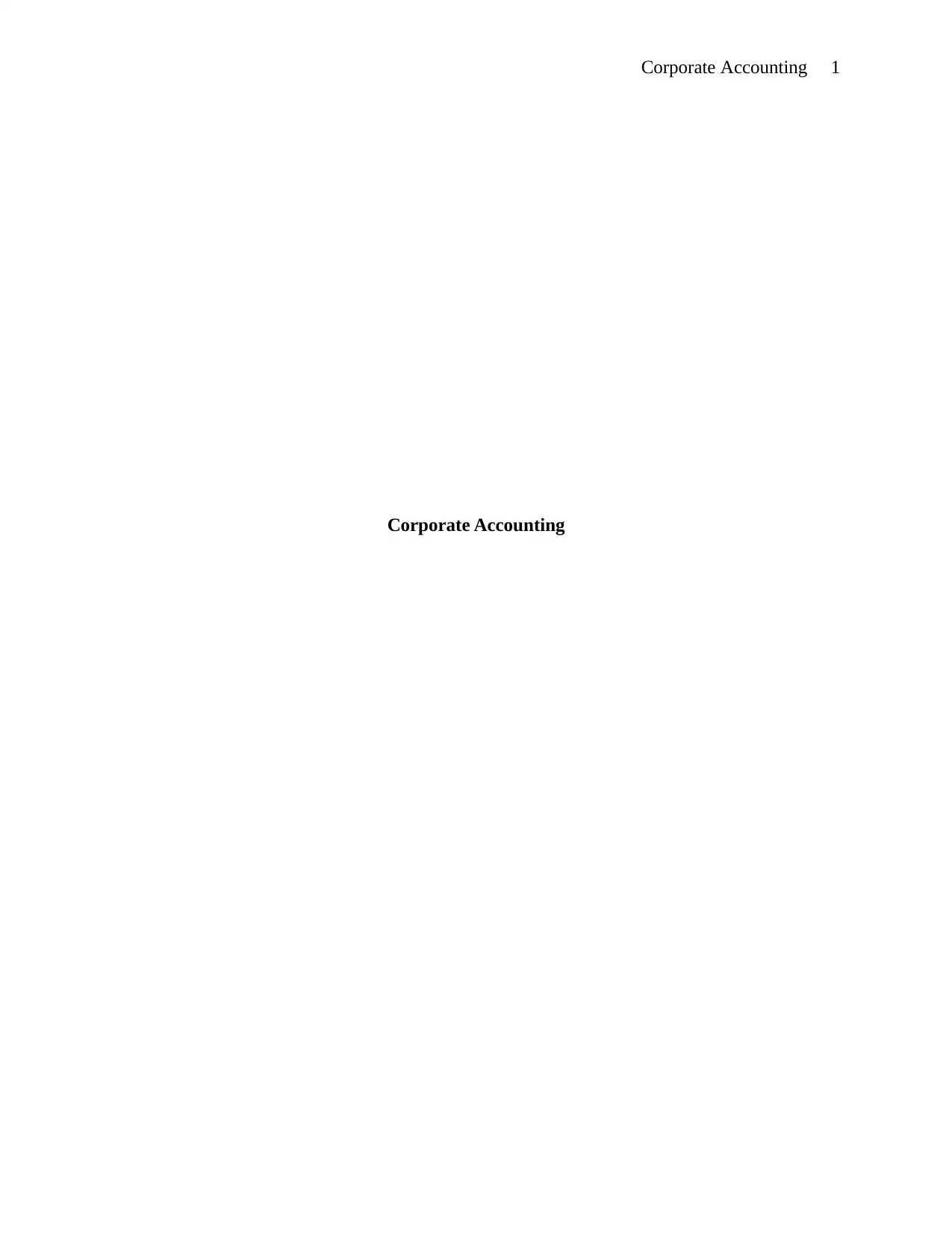
Corporate Accounting 1
Corporate Accounting
Corporate Accounting
Paraphrase This Document
Need a fresh take? Get an instant paraphrase of this document with our AI Paraphraser
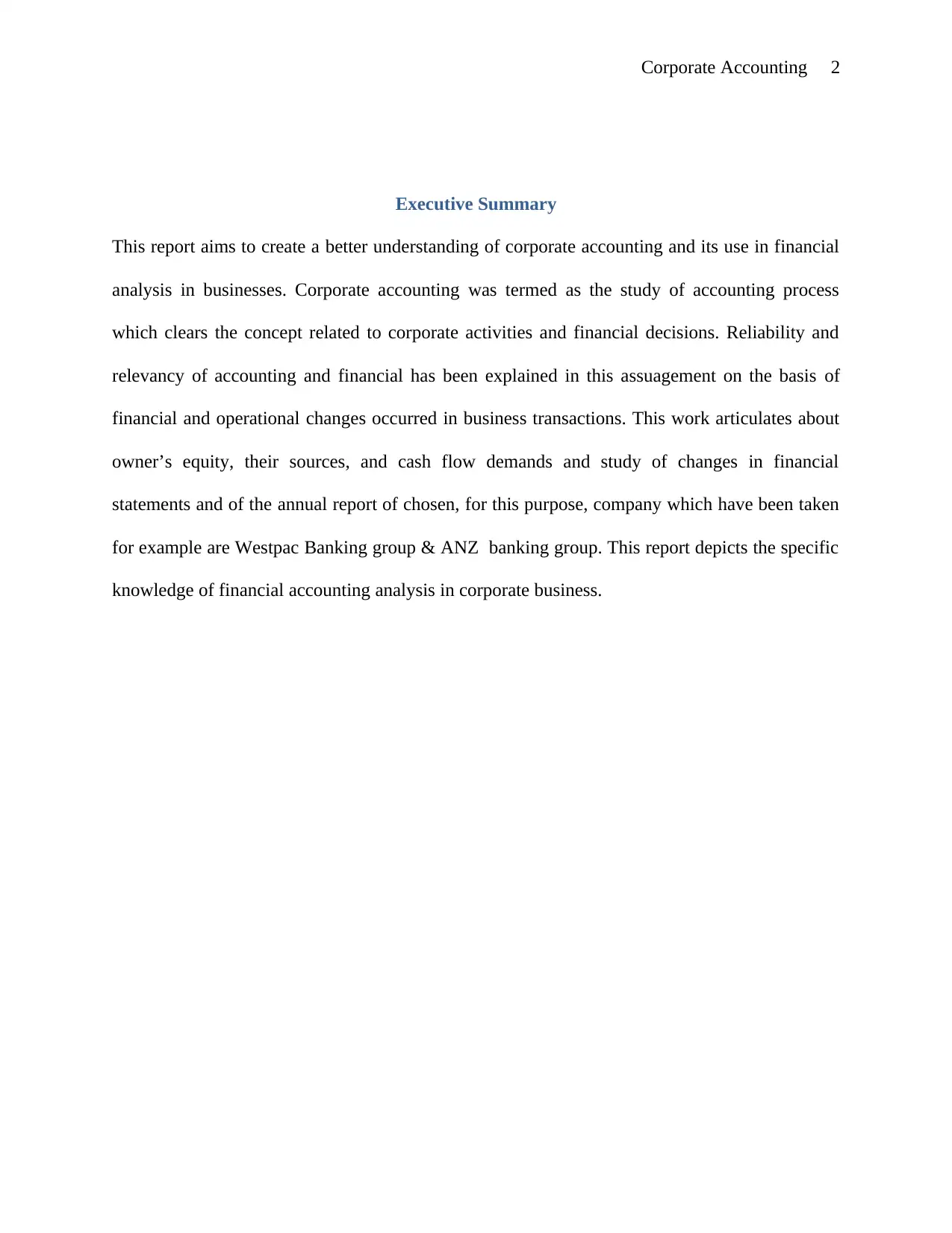
Corporate Accounting 2
Executive Summary
This report aims to create a better understanding of corporate accounting and its use in financial
analysis in businesses. Corporate accounting was termed as the study of accounting process
which clears the concept related to corporate activities and financial decisions. Reliability and
relevancy of accounting and financial has been explained in this assuagement on the basis of
financial and operational changes occurred in business transactions. This work articulates about
owner’s equity, their sources, and cash flow demands and study of changes in financial
statements and of the annual report of chosen, for this purpose, company which have been taken
for example are Westpac Banking group & ANZ banking group. This report depicts the specific
knowledge of financial accounting analysis in corporate business.
Executive Summary
This report aims to create a better understanding of corporate accounting and its use in financial
analysis in businesses. Corporate accounting was termed as the study of accounting process
which clears the concept related to corporate activities and financial decisions. Reliability and
relevancy of accounting and financial has been explained in this assuagement on the basis of
financial and operational changes occurred in business transactions. This work articulates about
owner’s equity, their sources, and cash flow demands and study of changes in financial
statements and of the annual report of chosen, for this purpose, company which have been taken
for example are Westpac Banking group & ANZ banking group. This report depicts the specific
knowledge of financial accounting analysis in corporate business.
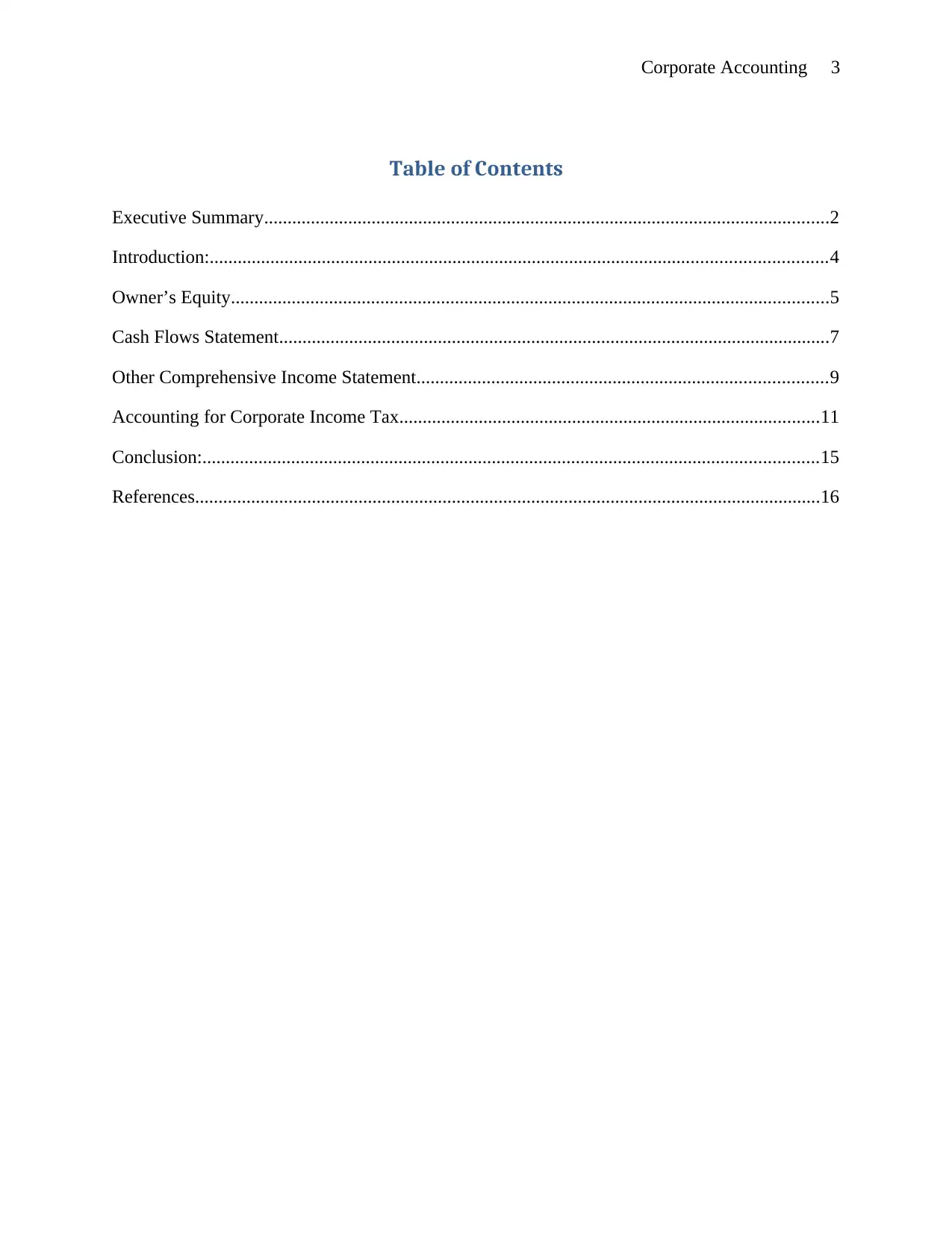
Corporate Accounting 3
Table of Contents
Executive Summary.........................................................................................................................2
Introduction:....................................................................................................................................4
Owner’s Equity................................................................................................................................5
Cash Flows Statement......................................................................................................................7
Other Comprehensive Income Statement........................................................................................9
Accounting for Corporate Income Tax..........................................................................................11
Conclusion:....................................................................................................................................15
References......................................................................................................................................16
Table of Contents
Executive Summary.........................................................................................................................2
Introduction:....................................................................................................................................4
Owner’s Equity................................................................................................................................5
Cash Flows Statement......................................................................................................................7
Other Comprehensive Income Statement........................................................................................9
Accounting for Corporate Income Tax..........................................................................................11
Conclusion:....................................................................................................................................15
References......................................................................................................................................16
⊘ This is a preview!⊘
Do you want full access?
Subscribe today to unlock all pages.

Trusted by 1+ million students worldwide
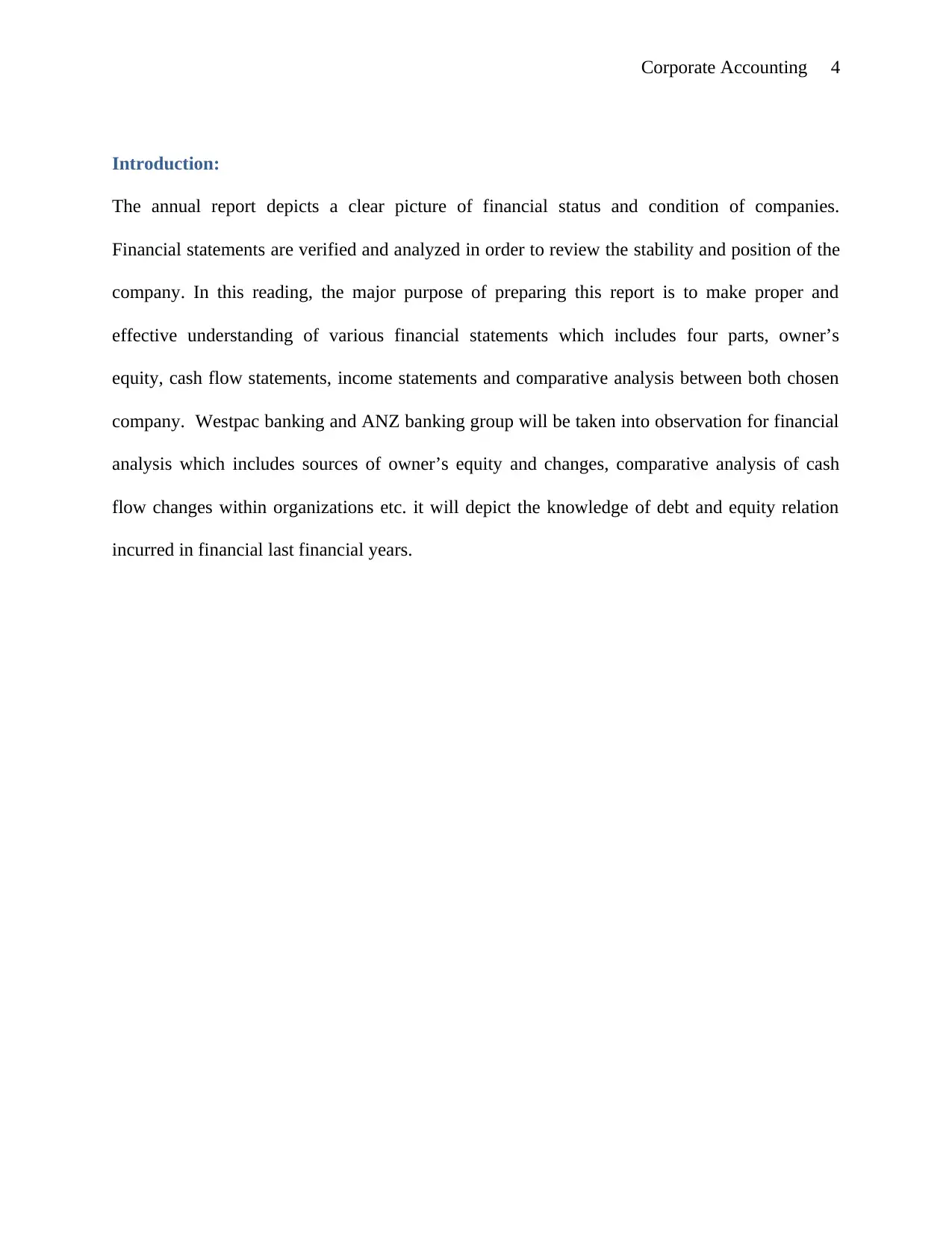
Corporate Accounting 4
Introduction:
The annual report depicts a clear picture of financial status and condition of companies.
Financial statements are verified and analyzed in order to review the stability and position of the
company. In this reading, the major purpose of preparing this report is to make proper and
effective understanding of various financial statements which includes four parts, owner’s
equity, cash flow statements, income statements and comparative analysis between both chosen
company. Westpac banking and ANZ banking group will be taken into observation for financial
analysis which includes sources of owner’s equity and changes, comparative analysis of cash
flow changes within organizations etc. it will depict the knowledge of debt and equity relation
incurred in financial last financial years.
Introduction:
The annual report depicts a clear picture of financial status and condition of companies.
Financial statements are verified and analyzed in order to review the stability and position of the
company. In this reading, the major purpose of preparing this report is to make proper and
effective understanding of various financial statements which includes four parts, owner’s
equity, cash flow statements, income statements and comparative analysis between both chosen
company. Westpac banking and ANZ banking group will be taken into observation for financial
analysis which includes sources of owner’s equity and changes, comparative analysis of cash
flow changes within organizations etc. it will depict the knowledge of debt and equity relation
incurred in financial last financial years.
Paraphrase This Document
Need a fresh take? Get an instant paraphrase of this document with our AI Paraphraser

Corporate Accounting 5
Owner’s Equity
(I)List of each item of equity and understanding & Changes in each item of equity
Owner’s equity: Owner’s equity is that equity which can be taken as a source of organizational
assets. Owner’s equity is the major word which can be used in the terms of a list of equity which
includes following things:
Common Stock: the common stock of owner’s equity can be taken ass ordinary shares of the
company, which was 275 in 2017 in Westpac Company; it was higher than the common stock of
ANZ Banking Limited.
Preferred Stock: Preferred stock: The unit of the share which is entitled to the stakeholders as a
fixed unit of dividend, whose payment has given the higher priority than the other ordinary stock
in the company. In 2017 Preferred stock of the Westpac banking was 2750 and 1974 in 2016
which has been increasing in the last five years. ANZ banking group’s preferred equity was nil
from last two years.
Retain Earning: Retained earnings are those profits which can be divided into profit, cash,
bonuses and dividend among shareholders. Total retain profit were 26,100 in 2017 of Westpac
banking and ANZ defined Retained profit around 18765 in 2017.
Accumulated other comprehensive income
In financial accounts of Westpac and ANZ banking group, it is needed to make of list of equity
items mentioned in the balance sheet of the companies.
In the financial statement of Westpac banking group, equity items which listed are: banking
corporations, total non-controlling interests, reserves, retained profits etc. on the other hand the
list of equity stated in the financial statement of ANZ Banking Group Company are: common
stocks, merged stocks and retained earning etc. The company has treasury stock which was in the
form of paid-in capital (Law, 2018).
Owner’s Equity
(I)List of each item of equity and understanding & Changes in each item of equity
Owner’s equity: Owner’s equity is that equity which can be taken as a source of organizational
assets. Owner’s equity is the major word which can be used in the terms of a list of equity which
includes following things:
Common Stock: the common stock of owner’s equity can be taken ass ordinary shares of the
company, which was 275 in 2017 in Westpac Company; it was higher than the common stock of
ANZ Banking Limited.
Preferred Stock: Preferred stock: The unit of the share which is entitled to the stakeholders as a
fixed unit of dividend, whose payment has given the higher priority than the other ordinary stock
in the company. In 2017 Preferred stock of the Westpac banking was 2750 and 1974 in 2016
which has been increasing in the last five years. ANZ banking group’s preferred equity was nil
from last two years.
Retain Earning: Retained earnings are those profits which can be divided into profit, cash,
bonuses and dividend among shareholders. Total retain profit were 26,100 in 2017 of Westpac
banking and ANZ defined Retained profit around 18765 in 2017.
Accumulated other comprehensive income
In financial accounts of Westpac and ANZ banking group, it is needed to make of list of equity
items mentioned in the balance sheet of the companies.
In the financial statement of Westpac banking group, equity items which listed are: banking
corporations, total non-controlling interests, reserves, retained profits etc. on the other hand the
list of equity stated in the financial statement of ANZ Banking Group Company are: common
stocks, merged stocks and retained earning etc. The company has treasury stock which was in the
form of paid-in capital (Law, 2018).
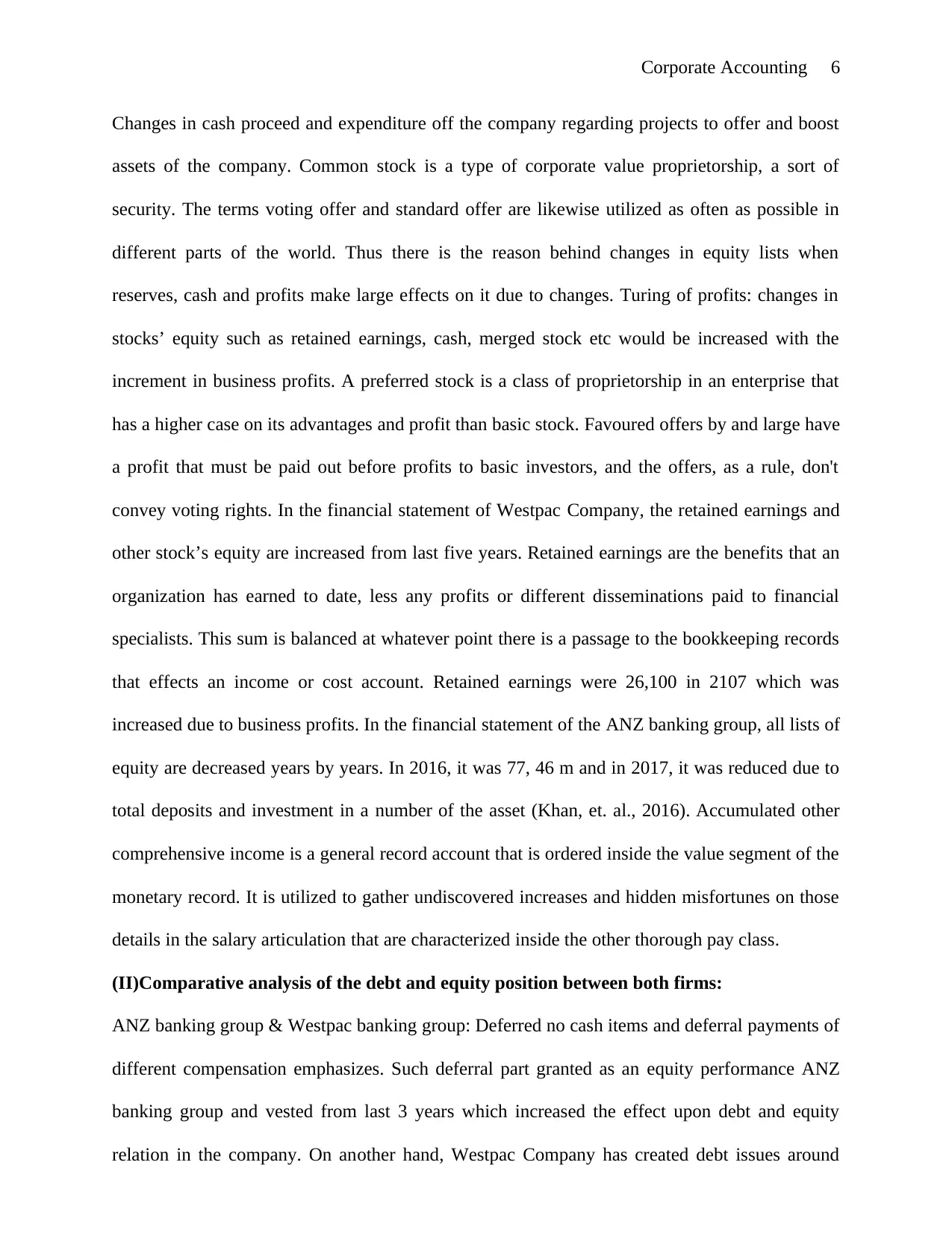
Corporate Accounting 6
Changes in cash proceed and expenditure off the company regarding projects to offer and boost
assets of the company. Common stock is a type of corporate value proprietorship, a sort of
security. The terms voting offer and standard offer are likewise utilized as often as possible in
different parts of the world. Thus there is the reason behind changes in equity lists when
reserves, cash and profits make large effects on it due to changes. Turing of profits: changes in
stocks’ equity such as retained earnings, cash, merged stock etc would be increased with the
increment in business profits. A preferred stock is a class of proprietorship in an enterprise that
has a higher case on its advantages and profit than basic stock. Favoured offers by and large have
a profit that must be paid out before profits to basic investors, and the offers, as a rule, don't
convey voting rights. In the financial statement of Westpac Company, the retained earnings and
other stock’s equity are increased from last five years. Retained earnings are the benefits that an
organization has earned to date, less any profits or different disseminations paid to financial
specialists. This sum is balanced at whatever point there is a passage to the bookkeeping records
that effects an income or cost account. Retained earnings were 26,100 in 2107 which was
increased due to business profits. In the financial statement of the ANZ banking group, all lists of
equity are decreased years by years. In 2016, it was 77, 46 m and in 2017, it was reduced due to
total deposits and investment in a number of the asset (Khan, et. al., 2016). Accumulated other
comprehensive income is a general record account that is ordered inside the value segment of the
monetary record. It is utilized to gather undiscovered increases and hidden misfortunes on those
details in the salary articulation that are characterized inside the other thorough pay class.
(II)Comparative analysis of the debt and equity position between both firms:
ANZ banking group & Westpac banking group: Deferred no cash items and deferral payments of
different compensation emphasizes. Such deferral part granted as an equity performance ANZ
banking group and vested from last 3 years which increased the effect upon debt and equity
relation in the company. On another hand, Westpac Company has created debt issues around
Changes in cash proceed and expenditure off the company regarding projects to offer and boost
assets of the company. Common stock is a type of corporate value proprietorship, a sort of
security. The terms voting offer and standard offer are likewise utilized as often as possible in
different parts of the world. Thus there is the reason behind changes in equity lists when
reserves, cash and profits make large effects on it due to changes. Turing of profits: changes in
stocks’ equity such as retained earnings, cash, merged stock etc would be increased with the
increment in business profits. A preferred stock is a class of proprietorship in an enterprise that
has a higher case on its advantages and profit than basic stock. Favoured offers by and large have
a profit that must be paid out before profits to basic investors, and the offers, as a rule, don't
convey voting rights. In the financial statement of Westpac Company, the retained earnings and
other stock’s equity are increased from last five years. Retained earnings are the benefits that an
organization has earned to date, less any profits or different disseminations paid to financial
specialists. This sum is balanced at whatever point there is a passage to the bookkeeping records
that effects an income or cost account. Retained earnings were 26,100 in 2107 which was
increased due to business profits. In the financial statement of the ANZ banking group, all lists of
equity are decreased years by years. In 2016, it was 77, 46 m and in 2017, it was reduced due to
total deposits and investment in a number of the asset (Khan, et. al., 2016). Accumulated other
comprehensive income is a general record account that is ordered inside the value segment of the
monetary record. It is utilized to gather undiscovered increases and hidden misfortunes on those
details in the salary articulation that are characterized inside the other thorough pay class.
(II)Comparative analysis of the debt and equity position between both firms:
ANZ banking group & Westpac banking group: Deferred no cash items and deferral payments of
different compensation emphasizes. Such deferral part granted as an equity performance ANZ
banking group and vested from last 3 years which increased the effect upon debt and equity
relation in the company. On another hand, Westpac Company has created debt issues around
⊘ This is a preview!⊘
Do you want full access?
Subscribe today to unlock all pages.

Trusted by 1+ million students worldwide
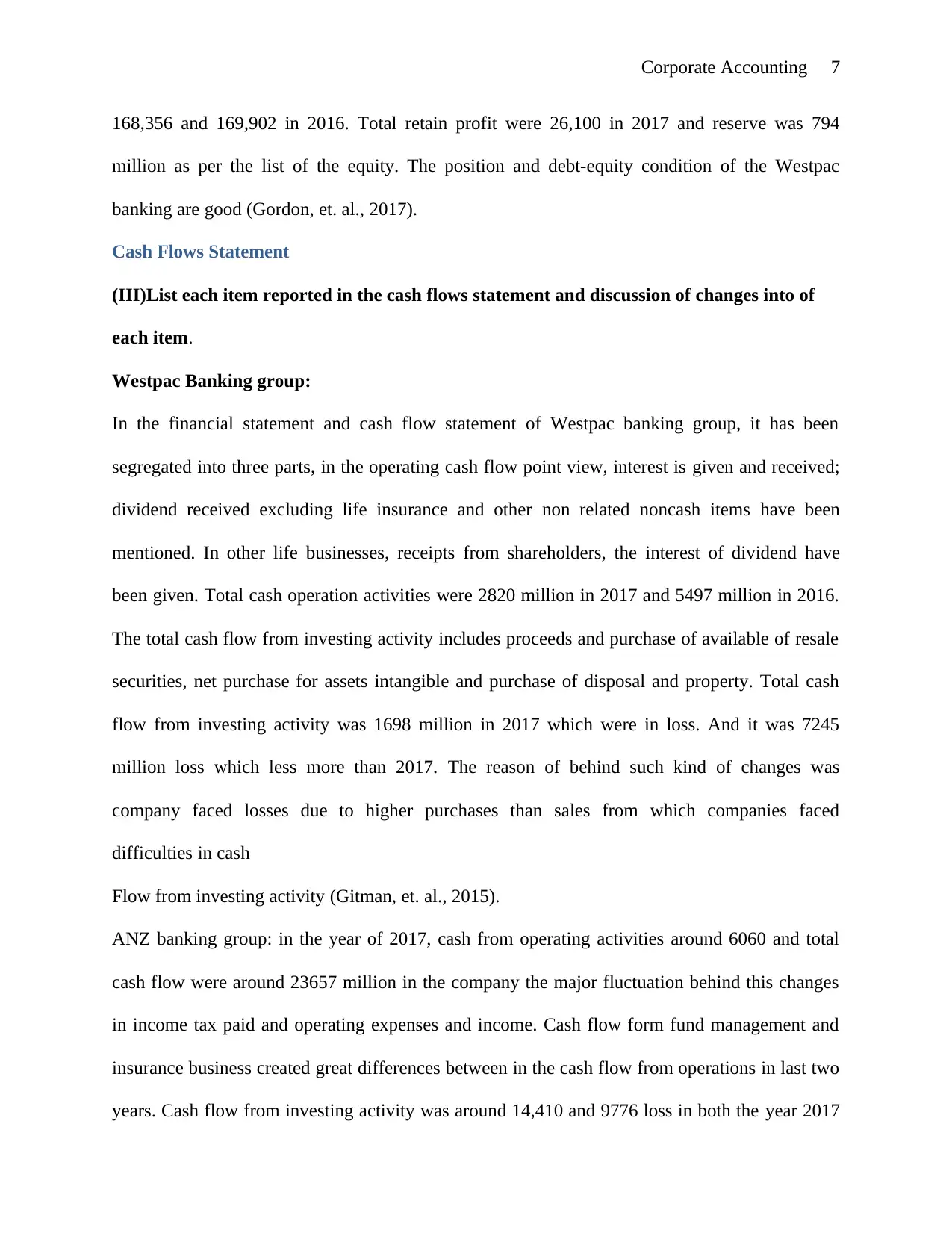
Corporate Accounting 7
168,356 and 169,902 in 2016. Total retain profit were 26,100 in 2017 and reserve was 794
million as per the list of the equity. The position and debt-equity condition of the Westpac
banking are good (Gordon, et. al., 2017).
Cash Flows Statement
(III)List each item reported in the cash flows statement and discussion of changes into of
each item.
Westpac Banking group:
In the financial statement and cash flow statement of Westpac banking group, it has been
segregated into three parts, in the operating cash flow point view, interest is given and received;
dividend received excluding life insurance and other non related noncash items have been
mentioned. In other life businesses, receipts from shareholders, the interest of dividend have
been given. Total cash operation activities were 2820 million in 2017 and 5497 million in 2016.
The total cash flow from investing activity includes proceeds and purchase of available of resale
securities, net purchase for assets intangible and purchase of disposal and property. Total cash
flow from investing activity was 1698 million in 2017 which were in loss. And it was 7245
million loss which less more than 2017. The reason of behind such kind of changes was
company faced losses due to higher purchases than sales from which companies faced
difficulties in cash
Flow from investing activity (Gitman, et. al., 2015).
ANZ banking group: in the year of 2017, cash from operating activities around 6060 and total
cash flow were around 23657 million in the company the major fluctuation behind this changes
in income tax paid and operating expenses and income. Cash flow form fund management and
insurance business created great differences between in the cash flow from operations in last two
years. Cash flow from investing activity was around 14,410 and 9776 loss in both the year 2017
168,356 and 169,902 in 2016. Total retain profit were 26,100 in 2017 and reserve was 794
million as per the list of the equity. The position and debt-equity condition of the Westpac
banking are good (Gordon, et. al., 2017).
Cash Flows Statement
(III)List each item reported in the cash flows statement and discussion of changes into of
each item.
Westpac Banking group:
In the financial statement and cash flow statement of Westpac banking group, it has been
segregated into three parts, in the operating cash flow point view, interest is given and received;
dividend received excluding life insurance and other non related noncash items have been
mentioned. In other life businesses, receipts from shareholders, the interest of dividend have
been given. Total cash operation activities were 2820 million in 2017 and 5497 million in 2016.
The total cash flow from investing activity includes proceeds and purchase of available of resale
securities, net purchase for assets intangible and purchase of disposal and property. Total cash
flow from investing activity was 1698 million in 2017 which were in loss. And it was 7245
million loss which less more than 2017. The reason of behind such kind of changes was
company faced losses due to higher purchases than sales from which companies faced
difficulties in cash
Flow from investing activity (Gitman, et. al., 2015).
ANZ banking group: in the year of 2017, cash from operating activities around 6060 and total
cash flow were around 23657 million in the company the major fluctuation behind this changes
in income tax paid and operating expenses and income. Cash flow form fund management and
insurance business created great differences between in the cash flow from operations in last two
years. Cash flow from investing activity was around 14,410 and 9776 loss in both the year 2017
Paraphrase This Document
Need a fresh take? Get an instant paraphrase of this document with our AI Paraphraser
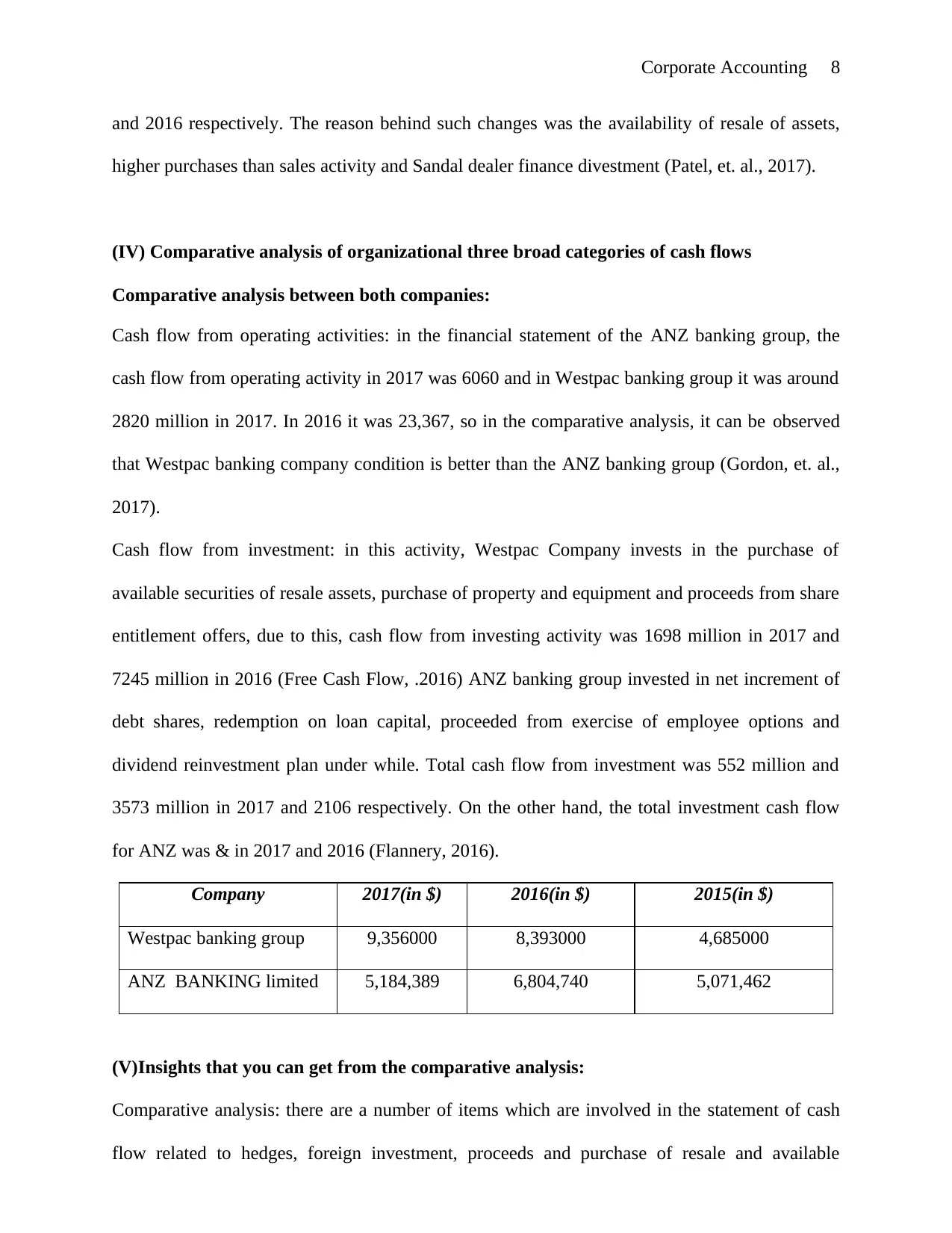
Corporate Accounting 8
and 2016 respectively. The reason behind such changes was the availability of resale of assets,
higher purchases than sales activity and Sandal dealer finance divestment (Patel, et. al., 2017).
(IV) Comparative analysis of organizational three broad categories of cash flows
Comparative analysis between both companies:
Cash flow from operating activities: in the financial statement of the ANZ banking group, the
cash flow from operating activity in 2017 was 6060 and in Westpac banking group it was around
2820 million in 2017. In 2016 it was 23,367, so in the comparative analysis, it can be observed
that Westpac banking company condition is better than the ANZ banking group (Gordon, et. al.,
2017).
Cash flow from investment: in this activity, Westpac Company invests in the purchase of
available securities of resale assets, purchase of property and equipment and proceeds from share
entitlement offers, due to this, cash flow from investing activity was 1698 million in 2017 and
7245 million in 2016 (Free Cash Flow, .2016) ANZ banking group invested in net increment of
debt shares, redemption on loan capital, proceeded from exercise of employee options and
dividend reinvestment plan under while. Total cash flow from investment was 552 million and
3573 million in 2017 and 2106 respectively. On the other hand, the total investment cash flow
for ANZ was & in 2017 and 2016 (Flannery, 2016).
Company 2017(in $) 2016(in $) 2015(in $)
Westpac banking group 9,356000 8,393000 4,685000
ANZ BANKING limited 5,184,389 6,804,740 5,071,462
(V)Insights that you can get from the comparative analysis:
Comparative analysis: there are a number of items which are involved in the statement of cash
flow related to hedges, foreign investment, proceeds and purchase of resale and available
and 2016 respectively. The reason behind such changes was the availability of resale of assets,
higher purchases than sales activity and Sandal dealer finance divestment (Patel, et. al., 2017).
(IV) Comparative analysis of organizational three broad categories of cash flows
Comparative analysis between both companies:
Cash flow from operating activities: in the financial statement of the ANZ banking group, the
cash flow from operating activity in 2017 was 6060 and in Westpac banking group it was around
2820 million in 2017. In 2016 it was 23,367, so in the comparative analysis, it can be observed
that Westpac banking company condition is better than the ANZ banking group (Gordon, et. al.,
2017).
Cash flow from investment: in this activity, Westpac Company invests in the purchase of
available securities of resale assets, purchase of property and equipment and proceeds from share
entitlement offers, due to this, cash flow from investing activity was 1698 million in 2017 and
7245 million in 2016 (Free Cash Flow, .2016) ANZ banking group invested in net increment of
debt shares, redemption on loan capital, proceeded from exercise of employee options and
dividend reinvestment plan under while. Total cash flow from investment was 552 million and
3573 million in 2017 and 2106 respectively. On the other hand, the total investment cash flow
for ANZ was & in 2017 and 2016 (Flannery, 2016).
Company 2017(in $) 2016(in $) 2015(in $)
Westpac banking group 9,356000 8,393000 4,685000
ANZ BANKING limited 5,184,389 6,804,740 5,071,462
(V)Insights that you can get from the comparative analysis:
Comparative analysis: there are a number of items which are involved in the statement of cash
flow related to hedges, foreign investment, proceeds and purchase of resale and available
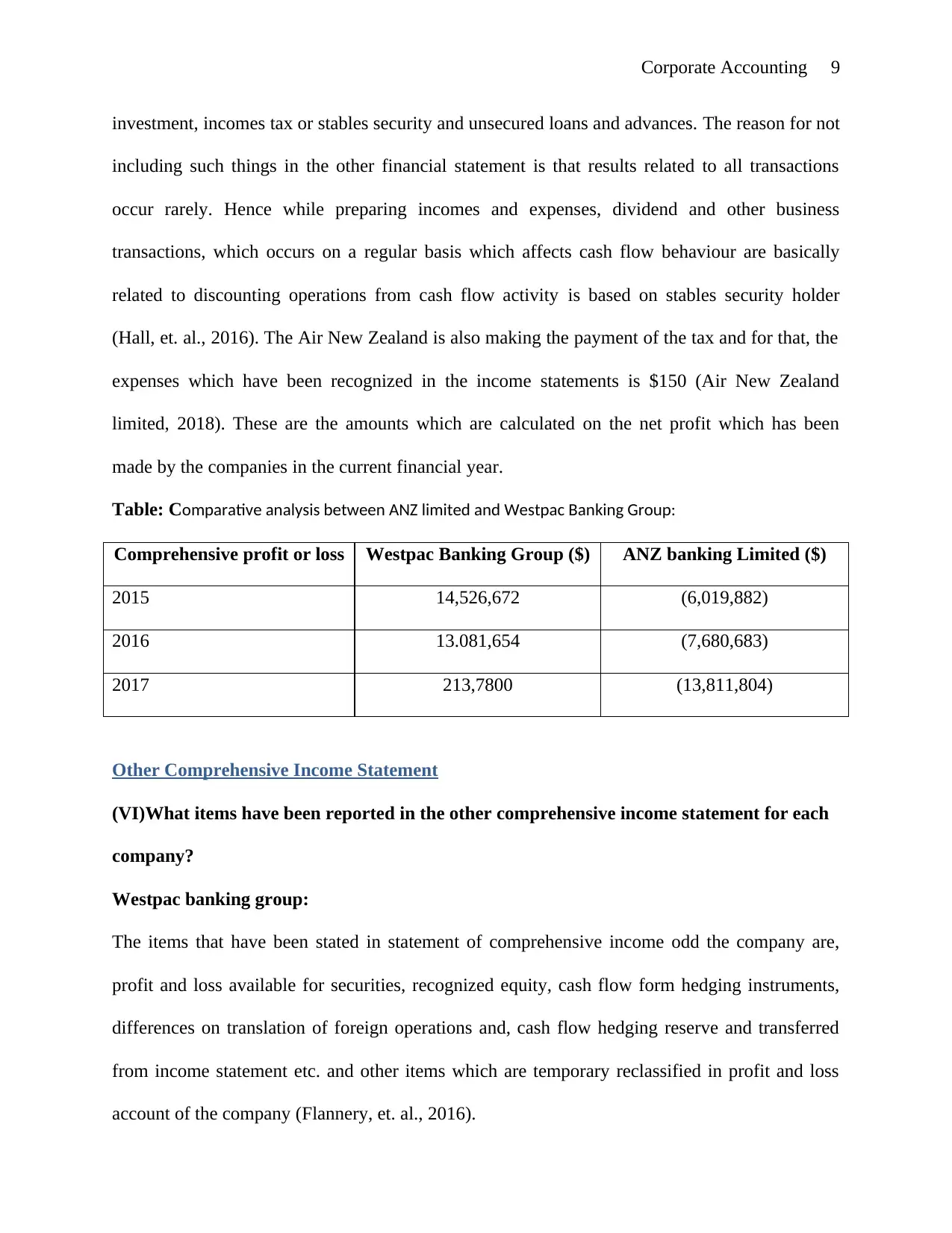
Corporate Accounting 9
investment, incomes tax or stables security and unsecured loans and advances. The reason for not
including such things in the other financial statement is that results related to all transactions
occur rarely. Hence while preparing incomes and expenses, dividend and other business
transactions, which occurs on a regular basis which affects cash flow behaviour are basically
related to discounting operations from cash flow activity is based on stables security holder
(Hall, et. al., 2016). The Air New Zealand is also making the payment of the tax and for that, the
expenses which have been recognized in the income statements is $150 (Air New Zealand
limited, 2018). These are the amounts which are calculated on the net profit which has been
made by the companies in the current financial year.
Table: Comparative analysis between ANZ limited and Westpac Banking Group:
Comprehensive profit or loss Westpac Banking Group ($) ANZ banking Limited ($)
2015 14,526,672 (6,019,882)
2016 13.081,654 (7,680,683)
2017 213,7800 (13,811,804)
Other Comprehensive Income Statement
(VI)What items have been reported in the other comprehensive income statement for each
company?
Westpac banking group:
The items that have been stated in statement of comprehensive income odd the company are,
profit and loss available for securities, recognized equity, cash flow form hedging instruments,
differences on translation of foreign operations and, cash flow hedging reserve and transferred
from income statement etc. and other items which are temporary reclassified in profit and loss
account of the company (Flannery, et. al., 2016).
investment, incomes tax or stables security and unsecured loans and advances. The reason for not
including such things in the other financial statement is that results related to all transactions
occur rarely. Hence while preparing incomes and expenses, dividend and other business
transactions, which occurs on a regular basis which affects cash flow behaviour are basically
related to discounting operations from cash flow activity is based on stables security holder
(Hall, et. al., 2016). The Air New Zealand is also making the payment of the tax and for that, the
expenses which have been recognized in the income statements is $150 (Air New Zealand
limited, 2018). These are the amounts which are calculated on the net profit which has been
made by the companies in the current financial year.
Table: Comparative analysis between ANZ limited and Westpac Banking Group:
Comprehensive profit or loss Westpac Banking Group ($) ANZ banking Limited ($)
2015 14,526,672 (6,019,882)
2016 13.081,654 (7,680,683)
2017 213,7800 (13,811,804)
Other Comprehensive Income Statement
(VI)What items have been reported in the other comprehensive income statement for each
company?
Westpac banking group:
The items that have been stated in statement of comprehensive income odd the company are,
profit and loss available for securities, recognized equity, cash flow form hedging instruments,
differences on translation of foreign operations and, cash flow hedging reserve and transferred
from income statement etc. and other items which are temporary reclassified in profit and loss
account of the company (Flannery, et. al., 2016).
⊘ This is a preview!⊘
Do you want full access?
Subscribe today to unlock all pages.

Trusted by 1+ million students worldwide
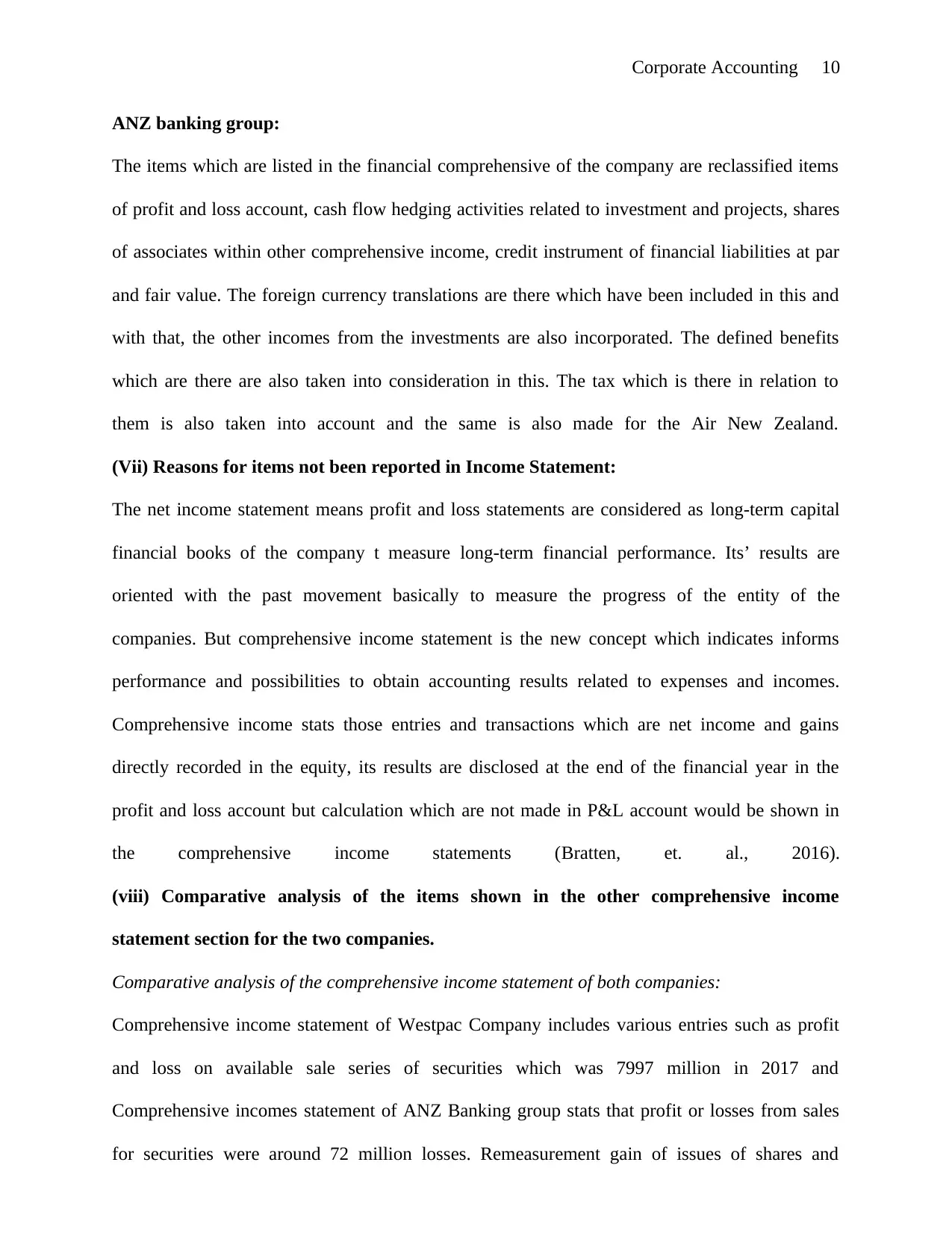
Corporate Accounting 10
ANZ banking group:
The items which are listed in the financial comprehensive of the company are reclassified items
of profit and loss account, cash flow hedging activities related to investment and projects, shares
of associates within other comprehensive income, credit instrument of financial liabilities at par
and fair value. The foreign currency translations are there which have been included in this and
with that, the other incomes from the investments are also incorporated. The defined benefits
which are there are also taken into consideration in this. The tax which is there in relation to
them is also taken into account and the same is also made for the Air New Zealand.
(Vii) Reasons for items not been reported in Income Statement:
The net income statement means profit and loss statements are considered as long-term capital
financial books of the company t measure long-term financial performance. Its’ results are
oriented with the past movement basically to measure the progress of the entity of the
companies. But comprehensive income statement is the new concept which indicates informs
performance and possibilities to obtain accounting results related to expenses and incomes.
Comprehensive income stats those entries and transactions which are net income and gains
directly recorded in the equity, its results are disclosed at the end of the financial year in the
profit and loss account but calculation which are not made in P&L account would be shown in
the comprehensive income statements (Bratten, et. al., 2016).
(viii) Comparative analysis of the items shown in the other comprehensive income
statement section for the two companies.
Comparative analysis of the comprehensive income statement of both companies:
Comprehensive income statement of Westpac Company includes various entries such as profit
and loss on available sale series of securities which was 7997 million in 2017 and
Comprehensive incomes statement of ANZ Banking group stats that profit or losses from sales
for securities were around 72 million losses. Remeasurement gain of issues of shares and
ANZ banking group:
The items which are listed in the financial comprehensive of the company are reclassified items
of profit and loss account, cash flow hedging activities related to investment and projects, shares
of associates within other comprehensive income, credit instrument of financial liabilities at par
and fair value. The foreign currency translations are there which have been included in this and
with that, the other incomes from the investments are also incorporated. The defined benefits
which are there are also taken into consideration in this. The tax which is there in relation to
them is also taken into account and the same is also made for the Air New Zealand.
(Vii) Reasons for items not been reported in Income Statement:
The net income statement means profit and loss statements are considered as long-term capital
financial books of the company t measure long-term financial performance. Its’ results are
oriented with the past movement basically to measure the progress of the entity of the
companies. But comprehensive income statement is the new concept which indicates informs
performance and possibilities to obtain accounting results related to expenses and incomes.
Comprehensive income stats those entries and transactions which are net income and gains
directly recorded in the equity, its results are disclosed at the end of the financial year in the
profit and loss account but calculation which are not made in P&L account would be shown in
the comprehensive income statements (Bratten, et. al., 2016).
(viii) Comparative analysis of the items shown in the other comprehensive income
statement section for the two companies.
Comparative analysis of the comprehensive income statement of both companies:
Comprehensive income statement of Westpac Company includes various entries such as profit
and loss on available sale series of securities which was 7997 million in 2017 and
Comprehensive incomes statement of ANZ Banking group stats that profit or losses from sales
for securities were around 72 million losses. Remeasurement gain of issues of shares and
Paraphrase This Document
Need a fresh take? Get an instant paraphrase of this document with our AI Paraphraser
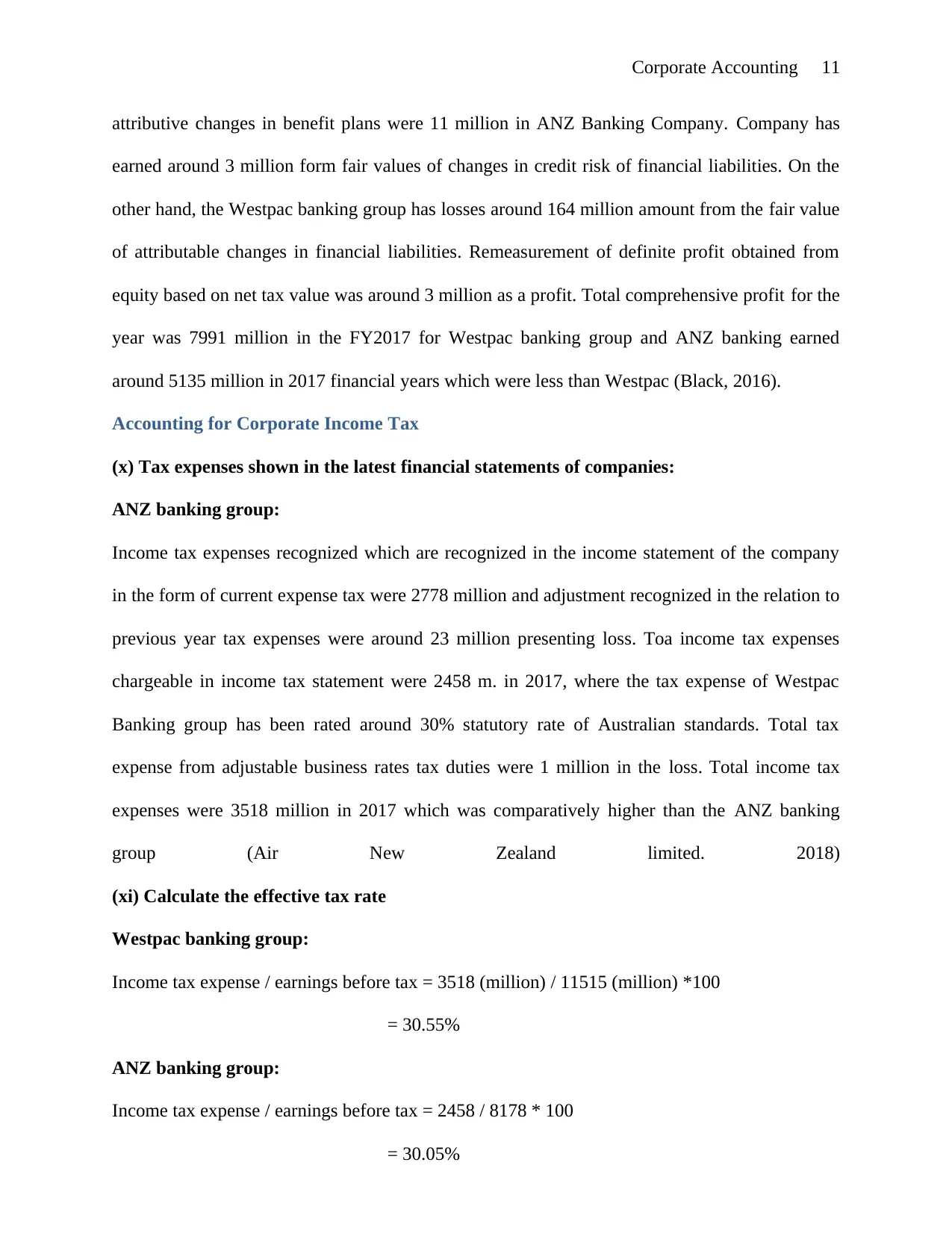
Corporate Accounting 11
attributive changes in benefit plans were 11 million in ANZ Banking Company. Company has
earned around 3 million form fair values of changes in credit risk of financial liabilities. On the
other hand, the Westpac banking group has losses around 164 million amount from the fair value
of attributable changes in financial liabilities. Remeasurement of definite profit obtained from
equity based on net tax value was around 3 million as a profit. Total comprehensive profit for the
year was 7991 million in the FY2017 for Westpac banking group and ANZ banking earned
around 5135 million in 2017 financial years which were less than Westpac (Black, 2016).
Accounting for Corporate Income Tax
(x) Tax expenses shown in the latest financial statements of companies:
ANZ banking group:
Income tax expenses recognized which are recognized in the income statement of the company
in the form of current expense tax were 2778 million and adjustment recognized in the relation to
previous year tax expenses were around 23 million presenting loss. Toa income tax expenses
chargeable in income tax statement were 2458 m. in 2017, where the tax expense of Westpac
Banking group has been rated around 30% statutory rate of Australian standards. Total tax
expense from adjustable business rates tax duties were 1 million in the loss. Total income tax
expenses were 3518 million in 2017 which was comparatively higher than the ANZ banking
group (Air New Zealand limited. 2018)
(xi) Calculate the effective tax rate
Westpac banking group:
Income tax expense / earnings before tax = 3518 (million) / 11515 (million) *100
= 30.55%
ANZ banking group:
Income tax expense / earnings before tax = 2458 / 8178 * 100
= 30.05%
attributive changes in benefit plans were 11 million in ANZ Banking Company. Company has
earned around 3 million form fair values of changes in credit risk of financial liabilities. On the
other hand, the Westpac banking group has losses around 164 million amount from the fair value
of attributable changes in financial liabilities. Remeasurement of definite profit obtained from
equity based on net tax value was around 3 million as a profit. Total comprehensive profit for the
year was 7991 million in the FY2017 for Westpac banking group and ANZ banking earned
around 5135 million in 2017 financial years which were less than Westpac (Black, 2016).
Accounting for Corporate Income Tax
(x) Tax expenses shown in the latest financial statements of companies:
ANZ banking group:
Income tax expenses recognized which are recognized in the income statement of the company
in the form of current expense tax were 2778 million and adjustment recognized in the relation to
previous year tax expenses were around 23 million presenting loss. Toa income tax expenses
chargeable in income tax statement were 2458 m. in 2017, where the tax expense of Westpac
Banking group has been rated around 30% statutory rate of Australian standards. Total tax
expense from adjustable business rates tax duties were 1 million in the loss. Total income tax
expenses were 3518 million in 2017 which was comparatively higher than the ANZ banking
group (Air New Zealand limited. 2018)
(xi) Calculate the effective tax rate
Westpac banking group:
Income tax expense / earnings before tax = 3518 (million) / 11515 (million) *100
= 30.55%
ANZ banking group:
Income tax expense / earnings before tax = 2458 / 8178 * 100
= 30.05%
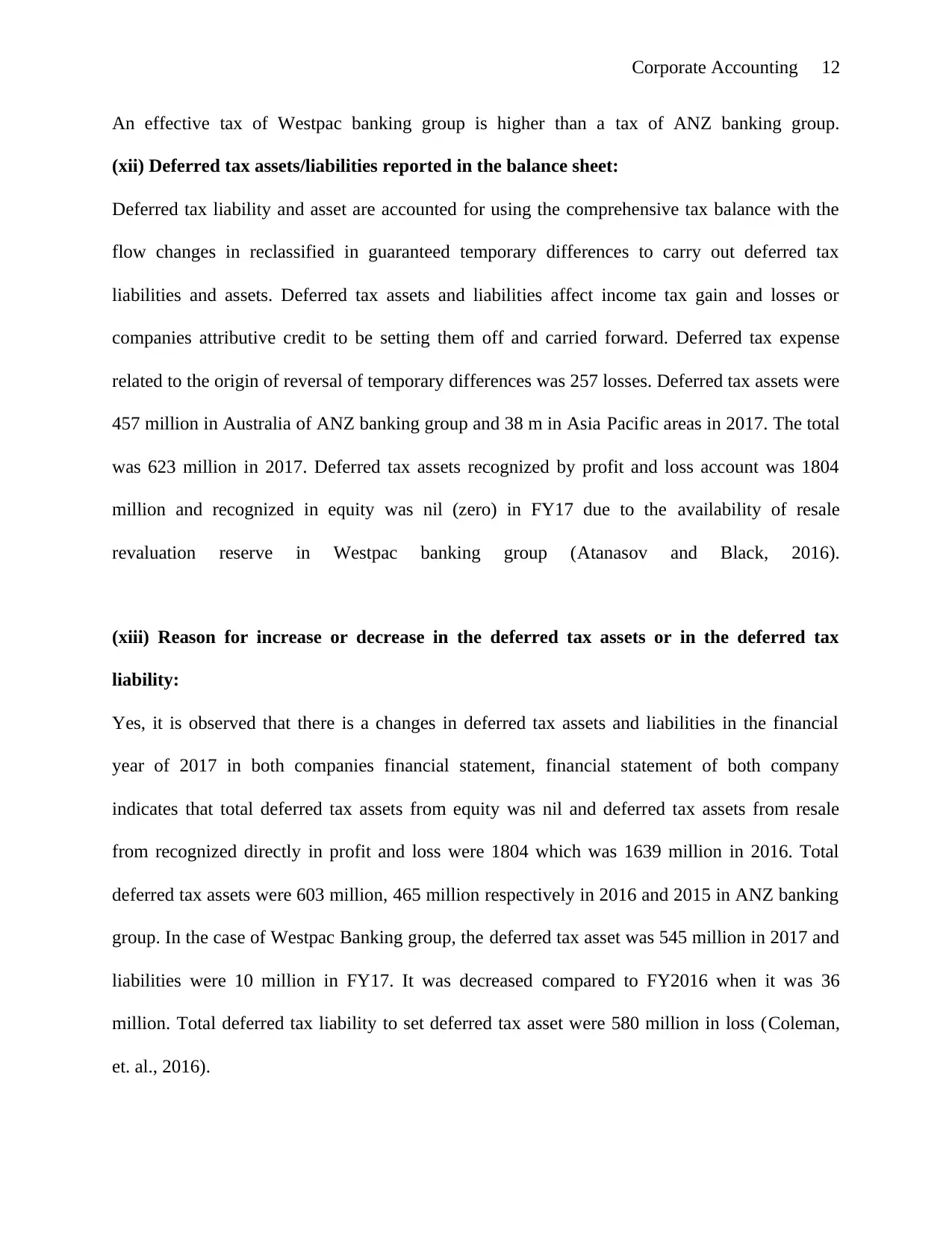
Corporate Accounting 12
An effective tax of Westpac banking group is higher than a tax of ANZ banking group.
(xii) Deferred tax assets/liabilities reported in the balance sheet:
Deferred tax liability and asset are accounted for using the comprehensive tax balance with the
flow changes in reclassified in guaranteed temporary differences to carry out deferred tax
liabilities and assets. Deferred tax assets and liabilities affect income tax gain and losses or
companies attributive credit to be setting them off and carried forward. Deferred tax expense
related to the origin of reversal of temporary differences was 257 losses. Deferred tax assets were
457 million in Australia of ANZ banking group and 38 m in Asia Pacific areas in 2017. The total
was 623 million in 2017. Deferred tax assets recognized by profit and loss account was 1804
million and recognized in equity was nil (zero) in FY17 due to the availability of resale
revaluation reserve in Westpac banking group (Atanasov and Black, 2016).
(xiii) Reason for increase or decrease in the deferred tax assets or in the deferred tax
liability:
Yes, it is observed that there is a changes in deferred tax assets and liabilities in the financial
year of 2017 in both companies financial statement, financial statement of both company
indicates that total deferred tax assets from equity was nil and deferred tax assets from resale
from recognized directly in profit and loss were 1804 which was 1639 million in 2016. Total
deferred tax assets were 603 million, 465 million respectively in 2016 and 2015 in ANZ banking
group. In the case of Westpac Banking group, the deferred tax asset was 545 million in 2017 and
liabilities were 10 million in FY17. It was decreased compared to FY2016 when it was 36
million. Total deferred tax liability to set deferred tax asset were 580 million in loss (Coleman,
et. al., 2016).
An effective tax of Westpac banking group is higher than a tax of ANZ banking group.
(xii) Deferred tax assets/liabilities reported in the balance sheet:
Deferred tax liability and asset are accounted for using the comprehensive tax balance with the
flow changes in reclassified in guaranteed temporary differences to carry out deferred tax
liabilities and assets. Deferred tax assets and liabilities affect income tax gain and losses or
companies attributive credit to be setting them off and carried forward. Deferred tax expense
related to the origin of reversal of temporary differences was 257 losses. Deferred tax assets were
457 million in Australia of ANZ banking group and 38 m in Asia Pacific areas in 2017. The total
was 623 million in 2017. Deferred tax assets recognized by profit and loss account was 1804
million and recognized in equity was nil (zero) in FY17 due to the availability of resale
revaluation reserve in Westpac banking group (Atanasov and Black, 2016).
(xiii) Reason for increase or decrease in the deferred tax assets or in the deferred tax
liability:
Yes, it is observed that there is a changes in deferred tax assets and liabilities in the financial
year of 2017 in both companies financial statement, financial statement of both company
indicates that total deferred tax assets from equity was nil and deferred tax assets from resale
from recognized directly in profit and loss were 1804 which was 1639 million in 2016. Total
deferred tax assets were 603 million, 465 million respectively in 2016 and 2015 in ANZ banking
group. In the case of Westpac Banking group, the deferred tax asset was 545 million in 2017 and
liabilities were 10 million in FY17. It was decreased compared to FY2016 when it was 36
million. Total deferred tax liability to set deferred tax asset were 580 million in loss (Coleman,
et. al., 2016).
⊘ This is a preview!⊘
Do you want full access?
Subscribe today to unlock all pages.

Trusted by 1+ million students worldwide
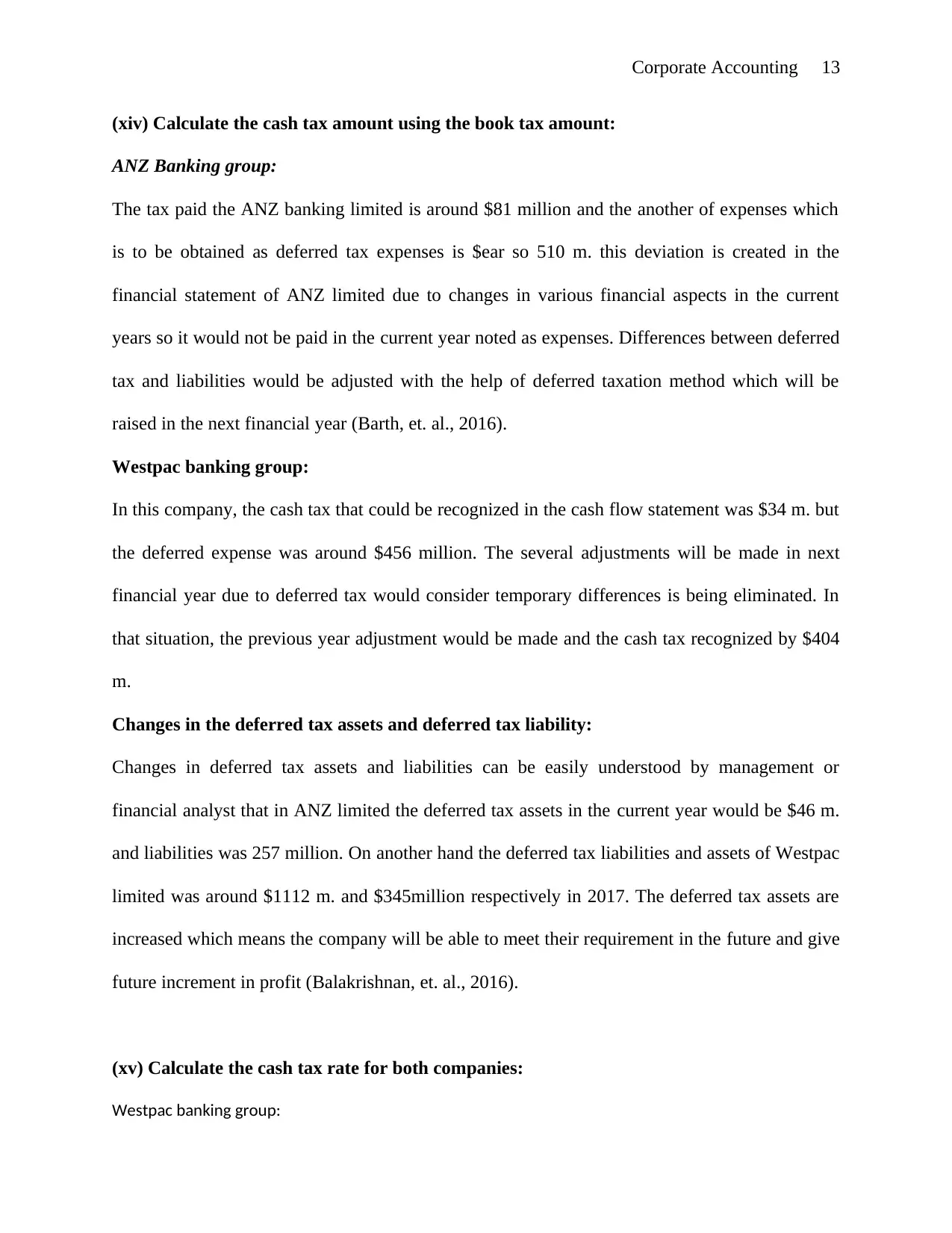
Corporate Accounting 13
(xiv) Calculate the cash tax amount using the book tax amount:
ANZ Banking group:
The tax paid the ANZ banking limited is around $81 million and the another of expenses which
is to be obtained as deferred tax expenses is $ear so 510 m. this deviation is created in the
financial statement of ANZ limited due to changes in various financial aspects in the current
years so it would not be paid in the current year noted as expenses. Differences between deferred
tax and liabilities would be adjusted with the help of deferred taxation method which will be
raised in the next financial year (Barth, et. al., 2016).
Westpac banking group:
In this company, the cash tax that could be recognized in the cash flow statement was $34 m. but
the deferred expense was around $456 million. The several adjustments will be made in next
financial year due to deferred tax would consider temporary differences is being eliminated. In
that situation, the previous year adjustment would be made and the cash tax recognized by $404
m.
Changes in the deferred tax assets and deferred tax liability:
Changes in deferred tax assets and liabilities can be easily understood by management or
financial analyst that in ANZ limited the deferred tax assets in the current year would be $46 m.
and liabilities was 257 million. On another hand the deferred tax liabilities and assets of Westpac
limited was around $1112 m. and $345million respectively in 2017. The deferred tax assets are
increased which means the company will be able to meet their requirement in the future and give
future increment in profit (Balakrishnan, et. al., 2016).
(xv) Calculate the cash tax rate for both companies:
Westpac banking group:
(xiv) Calculate the cash tax amount using the book tax amount:
ANZ Banking group:
The tax paid the ANZ banking limited is around $81 million and the another of expenses which
is to be obtained as deferred tax expenses is $ear so 510 m. this deviation is created in the
financial statement of ANZ limited due to changes in various financial aspects in the current
years so it would not be paid in the current year noted as expenses. Differences between deferred
tax and liabilities would be adjusted with the help of deferred taxation method which will be
raised in the next financial year (Barth, et. al., 2016).
Westpac banking group:
In this company, the cash tax that could be recognized in the cash flow statement was $34 m. but
the deferred expense was around $456 million. The several adjustments will be made in next
financial year due to deferred tax would consider temporary differences is being eliminated. In
that situation, the previous year adjustment would be made and the cash tax recognized by $404
m.
Changes in the deferred tax assets and deferred tax liability:
Changes in deferred tax assets and liabilities can be easily understood by management or
financial analyst that in ANZ limited the deferred tax assets in the current year would be $46 m.
and liabilities was 257 million. On another hand the deferred tax liabilities and assets of Westpac
limited was around $1112 m. and $345million respectively in 2017. The deferred tax assets are
increased which means the company will be able to meet their requirement in the future and give
future increment in profit (Balakrishnan, et. al., 2016).
(xv) Calculate the cash tax rate for both companies:
Westpac banking group:
Paraphrase This Document
Need a fresh take? Get an instant paraphrase of this document with our AI Paraphraser

Corporate Accounting 14
Particulars Amounts
Cash tax amount 87
EBIT 560
Cash tax rate 17%
ANZ banking group:
Particulars Amounts
Cash tax amount 81
EBT 540
Cash tax rate 15%
Through the above computation, it can be concluded that the condition of Westpac Banking
group is better than ANZ banking limited. By the support of the above calculation, it is observed
that the rate computed for ANZ is less than Westpac Group (Air New Zealand limited, 2017)
(xvi) Reason of cash tax rate different from the book tax rate:
The company has to identify the tax rate which is based on per cash payment and fair book value
of the tax. It is calculated as both of them might be different from one another. This is because of
cash tax and book tax paid by the company in terms of cash in the current year but book tax rate
is calculated on the total expense and cost for temporary motive and due to deviation and
fluctuations the rate of effective tax and cash tax effect (Awate, et. al., 2015).
Particulars Amounts
Cash tax amount 87
EBIT 560
Cash tax rate 17%
ANZ banking group:
Particulars Amounts
Cash tax amount 81
EBT 540
Cash tax rate 15%
Through the above computation, it can be concluded that the condition of Westpac Banking
group is better than ANZ banking limited. By the support of the above calculation, it is observed
that the rate computed for ANZ is less than Westpac Group (Air New Zealand limited, 2017)
(xvi) Reason of cash tax rate different from the book tax rate:
The company has to identify the tax rate which is based on per cash payment and fair book value
of the tax. It is calculated as both of them might be different from one another. This is because of
cash tax and book tax paid by the company in terms of cash in the current year but book tax rate
is calculated on the total expense and cost for temporary motive and due to deviation and
fluctuations the rate of effective tax and cash tax effect (Awate, et. al., 2015).
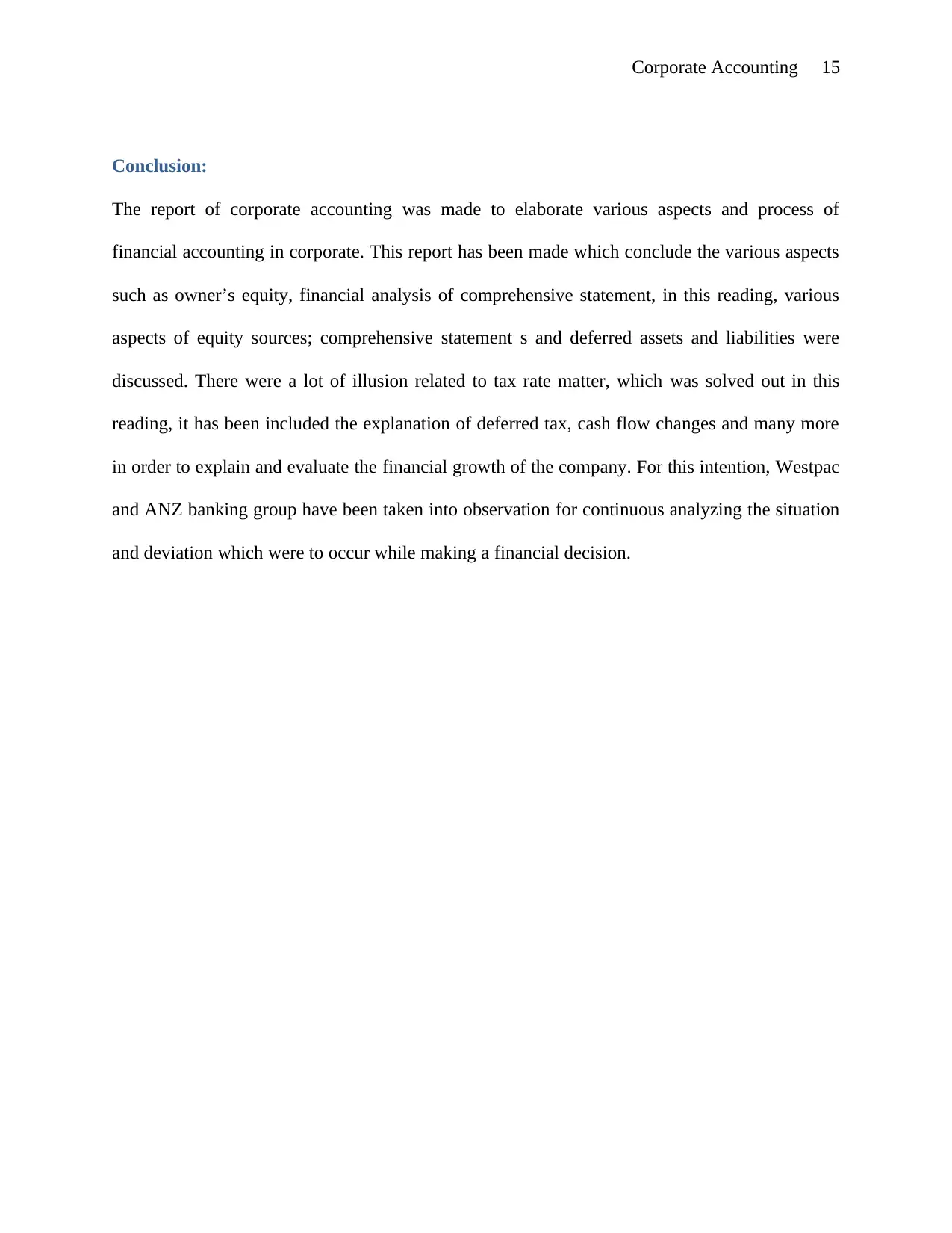
Corporate Accounting 15
Conclusion:
The report of corporate accounting was made to elaborate various aspects and process of
financial accounting in corporate. This report has been made which conclude the various aspects
such as owner’s equity, financial analysis of comprehensive statement, in this reading, various
aspects of equity sources; comprehensive statement s and deferred assets and liabilities were
discussed. There were a lot of illusion related to tax rate matter, which was solved out in this
reading, it has been included the explanation of deferred tax, cash flow changes and many more
in order to explain and evaluate the financial growth of the company. For this intention, Westpac
and ANZ banking group have been taken into observation for continuous analyzing the situation
and deviation which were to occur while making a financial decision.
Conclusion:
The report of corporate accounting was made to elaborate various aspects and process of
financial accounting in corporate. This report has been made which conclude the various aspects
such as owner’s equity, financial analysis of comprehensive statement, in this reading, various
aspects of equity sources; comprehensive statement s and deferred assets and liabilities were
discussed. There were a lot of illusion related to tax rate matter, which was solved out in this
reading, it has been included the explanation of deferred tax, cash flow changes and many more
in order to explain and evaluate the financial growth of the company. For this intention, Westpac
and ANZ banking group have been taken into observation for continuous analyzing the situation
and deviation which were to occur while making a financial decision.
⊘ This is a preview!⊘
Do you want full access?
Subscribe today to unlock all pages.

Trusted by 1+ million students worldwide
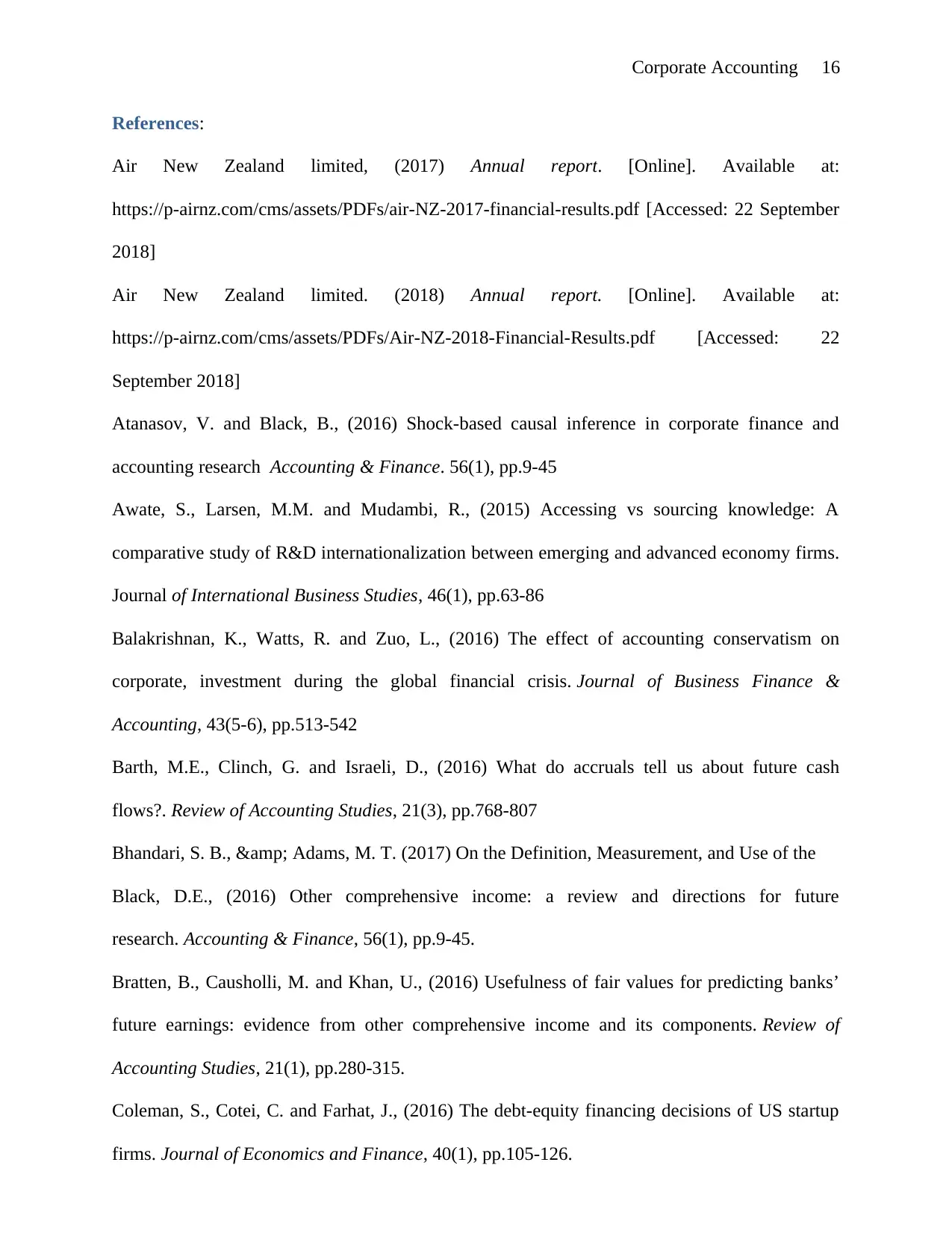
Corporate Accounting 16
References:
Air New Zealand limited, (2017) Annual report. [Online]. Available at:
https://p-airnz.com/cms/assets/PDFs/air-NZ-2017-financial-results.pdf [Accessed: 22 September
2018]
Air New Zealand limited. (2018) Annual report. [Online]. Available at:
https://p-airnz.com/cms/assets/PDFs/Air-NZ-2018-Financial-Results.pdf [Accessed: 22
September 2018]
Atanasov, V. and Black, B., (2016) Shock-based causal inference in corporate finance and
accounting research Accounting & Finance. 56(1), pp.9-45
Awate, S., Larsen, M.M. and Mudambi, R., (2015) Accessing vs sourcing knowledge: A
comparative study of R&D internationalization between emerging and advanced economy firms.
Journal of International Business Studies, 46(1), pp.63-86
Balakrishnan, K., Watts, R. and Zuo, L., (2016) The effect of accounting conservatism on
corporate, investment during the global financial crisis. Journal of Business Finance &
Accounting, 43(5-6), pp.513-542
Barth, M.E., Clinch, G. and Israeli, D., (2016) What do accruals tell us about future cash
flows?. Review of Accounting Studies, 21(3), pp.768-807
Bhandari, S. B., & Adams, M. T. (2017) On the Definition, Measurement, and Use of the
Black, D.E., (2016) Other comprehensive income: a review and directions for future
research. Accounting & Finance, 56(1), pp.9-45.
Bratten, B., Causholli, M. and Khan, U., (2016) Usefulness of fair values for predicting banks’
future earnings: evidence from other comprehensive income and its components. Review of
Accounting Studies, 21(1), pp.280-315.
Coleman, S., Cotei, C. and Farhat, J., (2016) The debt-equity financing decisions of US startup
firms. Journal of Economics and Finance, 40(1), pp.105-126.
References:
Air New Zealand limited, (2017) Annual report. [Online]. Available at:
https://p-airnz.com/cms/assets/PDFs/air-NZ-2017-financial-results.pdf [Accessed: 22 September
2018]
Air New Zealand limited. (2018) Annual report. [Online]. Available at:
https://p-airnz.com/cms/assets/PDFs/Air-NZ-2018-Financial-Results.pdf [Accessed: 22
September 2018]
Atanasov, V. and Black, B., (2016) Shock-based causal inference in corporate finance and
accounting research Accounting & Finance. 56(1), pp.9-45
Awate, S., Larsen, M.M. and Mudambi, R., (2015) Accessing vs sourcing knowledge: A
comparative study of R&D internationalization between emerging and advanced economy firms.
Journal of International Business Studies, 46(1), pp.63-86
Balakrishnan, K., Watts, R. and Zuo, L., (2016) The effect of accounting conservatism on
corporate, investment during the global financial crisis. Journal of Business Finance &
Accounting, 43(5-6), pp.513-542
Barth, M.E., Clinch, G. and Israeli, D., (2016) What do accruals tell us about future cash
flows?. Review of Accounting Studies, 21(3), pp.768-807
Bhandari, S. B., & Adams, M. T. (2017) On the Definition, Measurement, and Use of the
Black, D.E., (2016) Other comprehensive income: a review and directions for future
research. Accounting & Finance, 56(1), pp.9-45.
Bratten, B., Causholli, M. and Khan, U., (2016) Usefulness of fair values for predicting banks’
future earnings: evidence from other comprehensive income and its components. Review of
Accounting Studies, 21(1), pp.280-315.
Coleman, S., Cotei, C. and Farhat, J., (2016) The debt-equity financing decisions of US startup
firms. Journal of Economics and Finance, 40(1), pp.105-126.
Paraphrase This Document
Need a fresh take? Get an instant paraphrase of this document with our AI Paraphraser
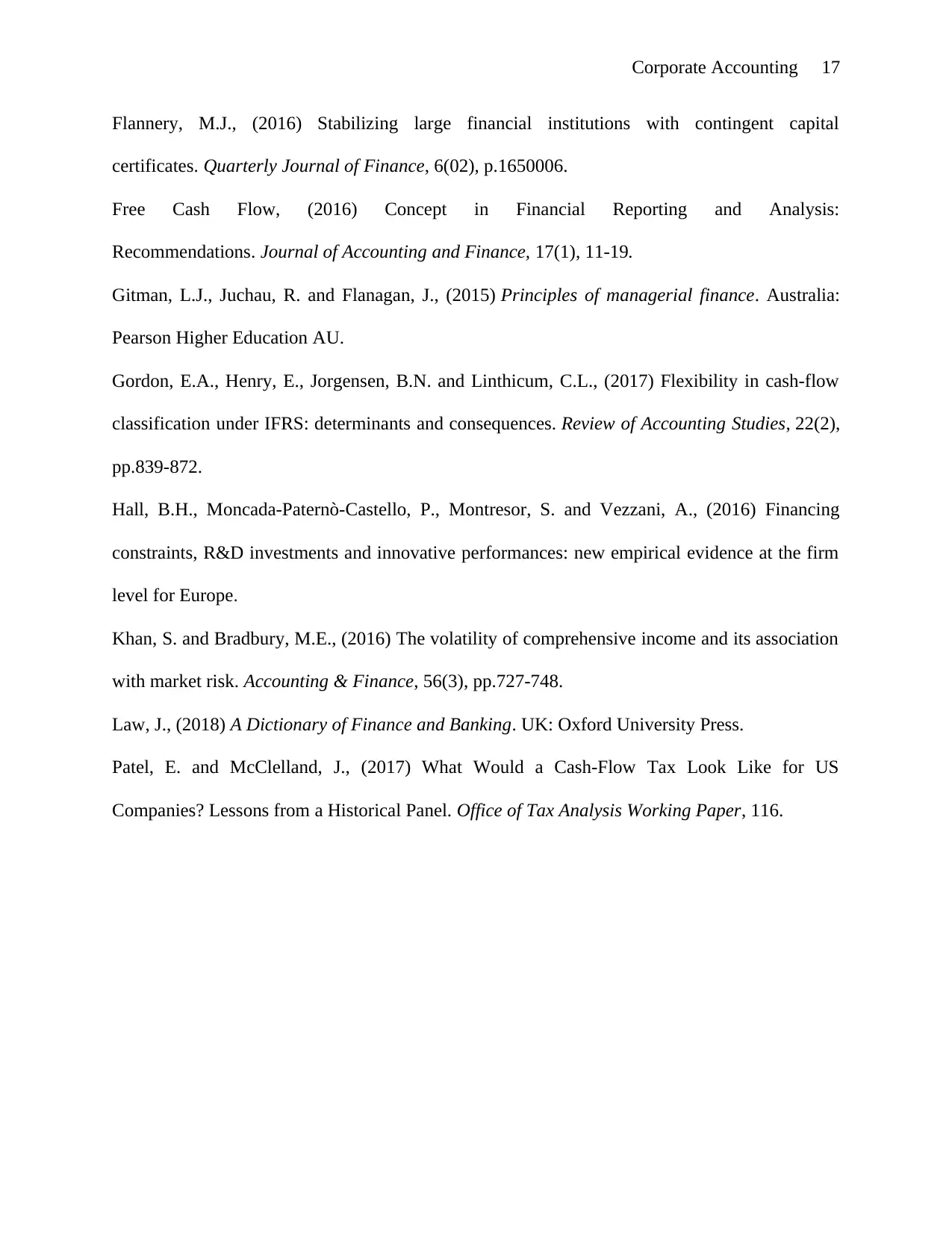
Corporate Accounting 17
Flannery, M.J., (2016) Stabilizing large financial institutions with contingent capital
certificates. Quarterly Journal of Finance, 6(02), p.1650006.
Free Cash Flow, (2016) Concept in Financial Reporting and Analysis:
Recommendations. Journal of Accounting and Finance, 17(1), 11-19.
Gitman, L.J., Juchau, R. and Flanagan, J., (2015) Principles of managerial finance. Australia:
Pearson Higher Education AU.
Gordon, E.A., Henry, E., Jorgensen, B.N. and Linthicum, C.L., (2017) Flexibility in cash-flow
classification under IFRS: determinants and consequences. Review of Accounting Studies, 22(2),
pp.839-872.
Hall, B.H., Moncada-Paternò-Castello, P., Montresor, S. and Vezzani, A., (2016) Financing
constraints, R&D investments and innovative performances: new empirical evidence at the firm
level for Europe.
Khan, S. and Bradbury, M.E., (2016) The volatility of comprehensive income and its association
with market risk. Accounting & Finance, 56(3), pp.727-748.
Law, J., (2018) A Dictionary of Finance and Banking. UK: Oxford University Press.
Patel, E. and McClelland, J., (2017) What Would a Cash-Flow Tax Look Like for US
Companies? Lessons from a Historical Panel. Office of Tax Analysis Working Paper, 116.
Flannery, M.J., (2016) Stabilizing large financial institutions with contingent capital
certificates. Quarterly Journal of Finance, 6(02), p.1650006.
Free Cash Flow, (2016) Concept in Financial Reporting and Analysis:
Recommendations. Journal of Accounting and Finance, 17(1), 11-19.
Gitman, L.J., Juchau, R. and Flanagan, J., (2015) Principles of managerial finance. Australia:
Pearson Higher Education AU.
Gordon, E.A., Henry, E., Jorgensen, B.N. and Linthicum, C.L., (2017) Flexibility in cash-flow
classification under IFRS: determinants and consequences. Review of Accounting Studies, 22(2),
pp.839-872.
Hall, B.H., Moncada-Paternò-Castello, P., Montresor, S. and Vezzani, A., (2016) Financing
constraints, R&D investments and innovative performances: new empirical evidence at the firm
level for Europe.
Khan, S. and Bradbury, M.E., (2016) The volatility of comprehensive income and its association
with market risk. Accounting & Finance, 56(3), pp.727-748.
Law, J., (2018) A Dictionary of Finance and Banking. UK: Oxford University Press.
Patel, E. and McClelland, J., (2017) What Would a Cash-Flow Tax Look Like for US
Companies? Lessons from a Historical Panel. Office of Tax Analysis Working Paper, 116.
1 out of 17
Related Documents
Your All-in-One AI-Powered Toolkit for Academic Success.
+13062052269
info@desklib.com
Available 24*7 on WhatsApp / Email
![[object Object]](/_next/static/media/star-bottom.7253800d.svg)
Unlock your academic potential
© 2024 | Zucol Services PVT LTD | All rights reserved.




